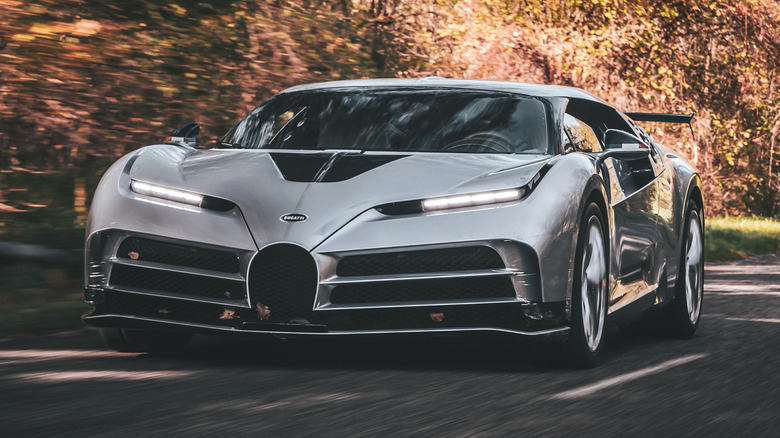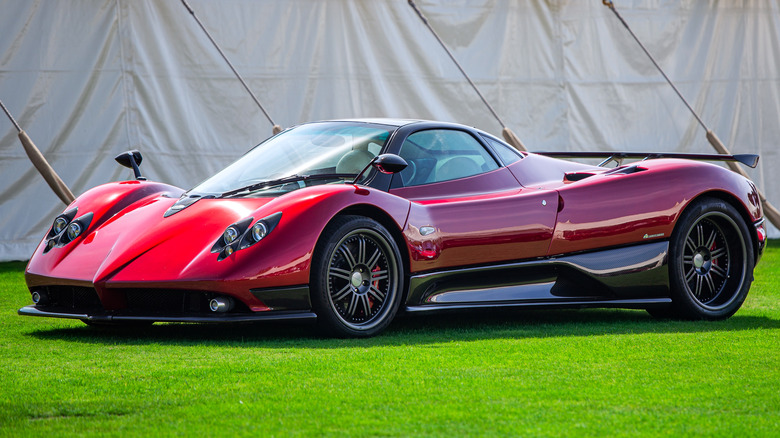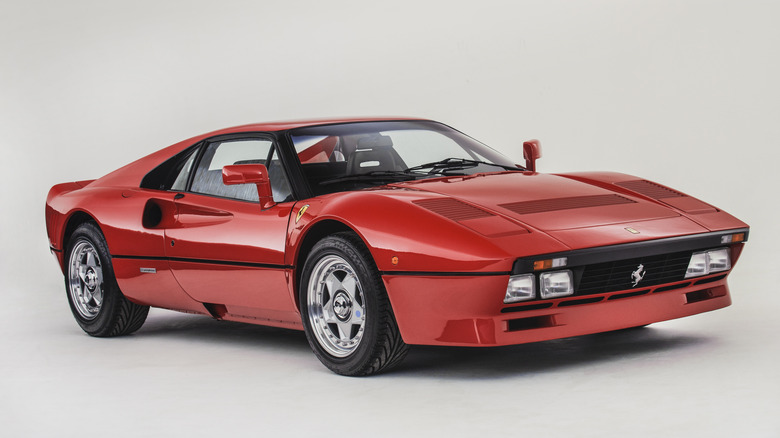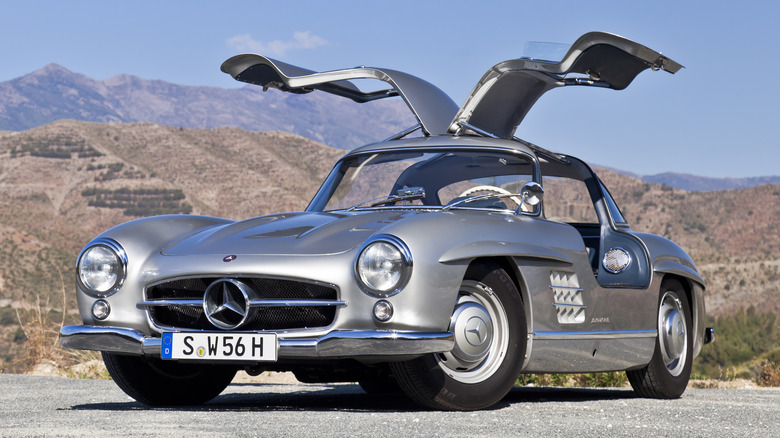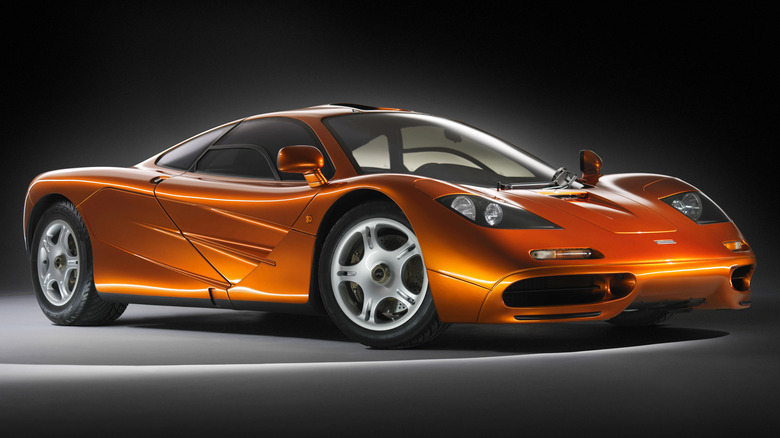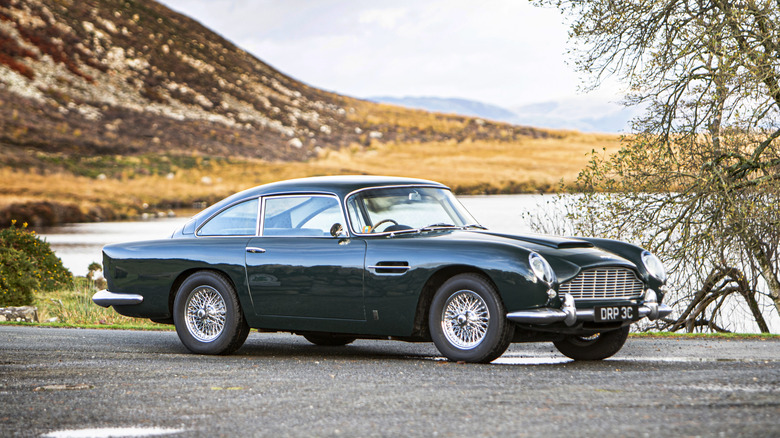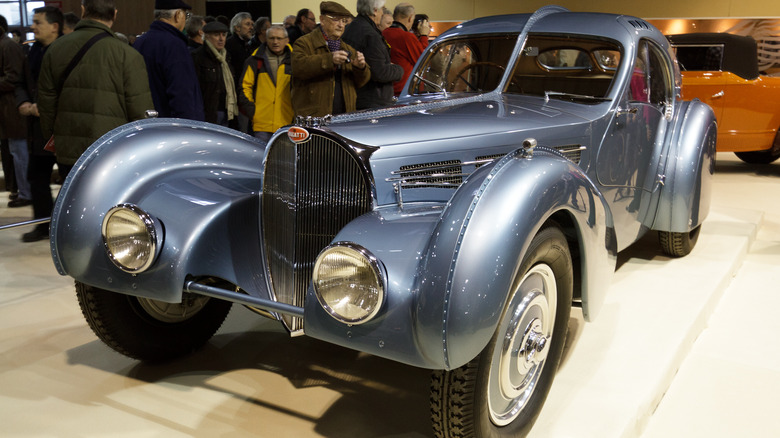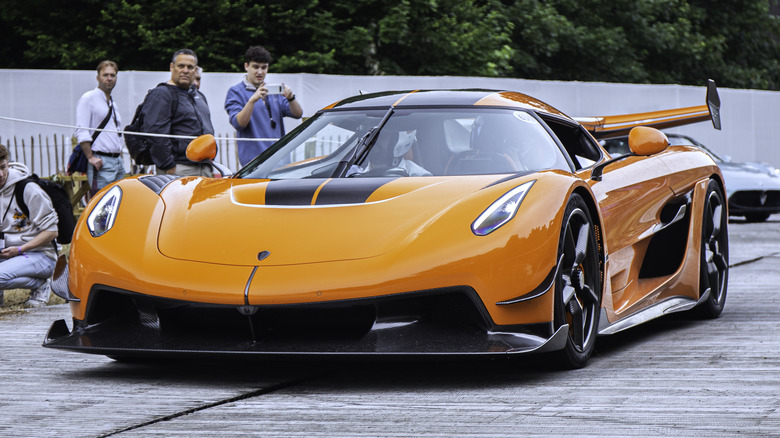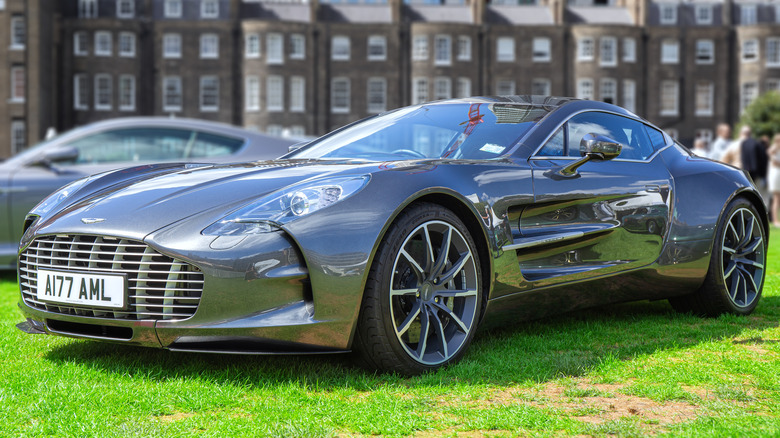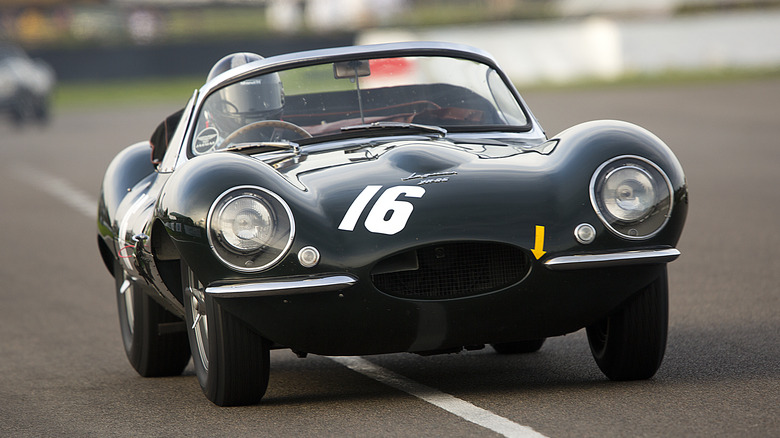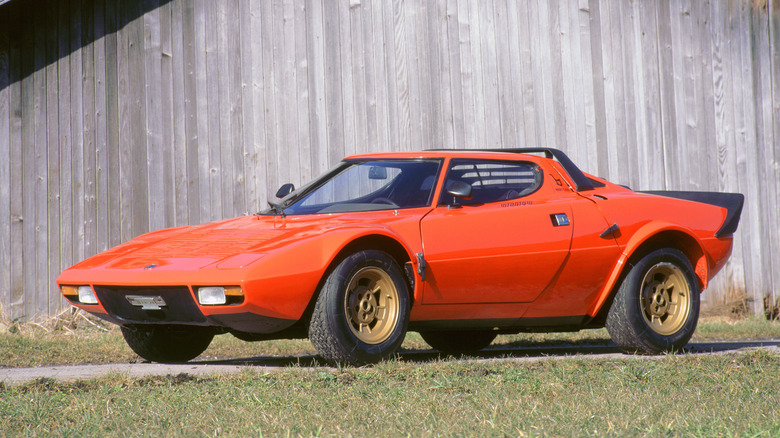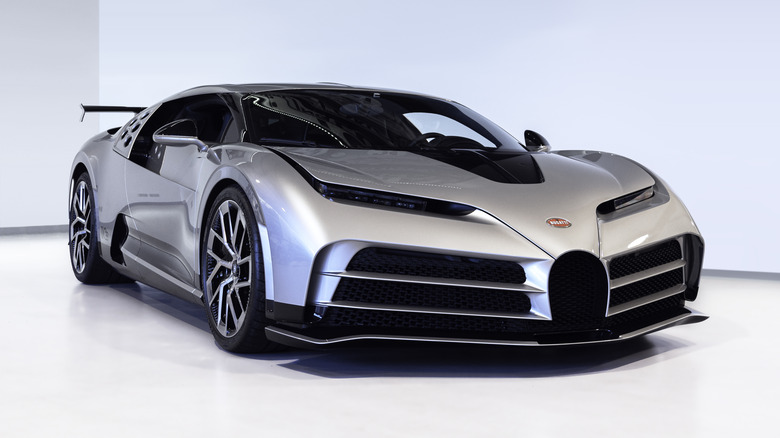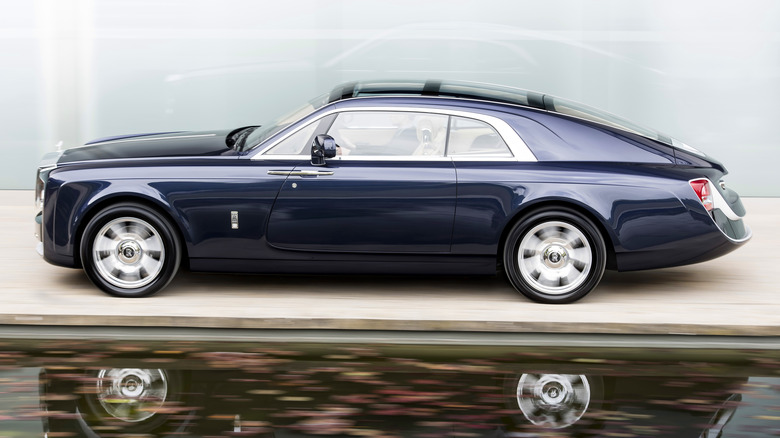12 Of The Most Incredible Handmade Cars Ever Built
Henry Ford introduced the first rolling assembly line in 1913, revolutionizing the car-making process by cutting costs and labor. Ever since, mass production methods have continued to get ever more efficient, and today, the largest automotive plants in the world produce cars at volumes that Mr. Ford could never have imagined. However, as much as a mass-made car is cheaper, quicker to make, and more uniformly built, it's never quite going to match the allure of a hand-crafted vehicle.
Hand-crafted cars are exclusive by nature — there are only so many craftsmen with the skills to make them, which puts a strict limit on the number of cars that can be produced. The privilege of hand assembly is usually reserved for the most luxurious, powerful, or exclusive models any brand has to offer. Still, some stand out above the rest as particularly outstanding examples of why handmade cars will always be superior to their mass-made rivals. With that said, here are 12 of our all-time favorites from across the decades.
Pagani Zonda
While it can't boast the same extensive history as other Italian greats like Ferrari or Lamborghini, Pagani's cars are just as jaw-dropping as anything to come out of Maranello or Sant'Agata. The vision of Horacio Pagani, the Zonda, was the marque's first supercar, originally debuting in 1999. Its success propelled Pagani from an unknown startup to an established industry force, and spawned dozens of special editions spanning two decades of production.
Like most small carmakers, Pagani had no access to bigger rivals' mass-production technologies, so every car was made by hand. The team behind it might have been small, but the Zonda's high-powered AMG V12 engine combined with the liberal use of weight-saving carbon fiber meant it could compete with the best in class. In fact, as well as being one of the earliest hypercars, the Zonda is still considered by many to be one of the best to date. As successful as the Zonda was, its low production numbers meant that it was never financially viable to certify the car for American road use, and as a result, it's still banned from the USA. However, a handful of examples have made their way over under-show and display exemptions over the years.
Ferrari 288 GTO
The first of Ferrari's line of halo cars, the 288 GTO nearly didn't make it to customers. It was the byproduct of Enzo Ferrari's desire to enter Group B racing, and when the class was banned after a series of tragic accidents, the car's future looked uncertain. However, Ferrari had already taken deposits for the road-going homologation car, and decided to build it anyway. The car proved to be so popular that the original planned run of 200 hand-built units was extended to 272, and many original reservations were sold to secondary buyers for significant profits.
Although the 288 GTO shared some visual similarities with the mass-produced 308, it was almost entirely different underneath. The car sported a longitudinally mounted V8 engine with twin turbochargers — a first for a Ferrari road car — and made 400 horsepower. Using composite materials helped keep weight to a minimum, resulting in the GTO being incredibly quick to drive. Its success encouraged Ferrari to develop further limited-run halo cars, with the next in the series being the revered F40.
Mercedes-Benz 300 SL Gullwing
Developing the 300 SL Gullwing was a significant gamble for Mercedes-Benz: German automakers were only just beginning to pick themselves up after the war, and it remained unclear how well a German-made sports car would sell internationally. However, an American dealer named Max Hoffman was insistent that such a car would do well in the U.S., and so Mercedes-Benz obliged on the condition that Hoffman would buy the first 500 units of the car.
The Gullwing was essentially a road-going version of its 300 SL race car, complete with lightweight body panels, a steel spaceframe, and a straight six engine. The spaceframe was the reason for the car's iconic doors — Mercedes couldn't fit conventional doors without removing part of the frame and therefore compromising the car's rigidity, so the Gullwing doors were developed instead. Today, the Gullwing is one of the most sought-after collectors' cars in the world, and an ultra-rare 300 SLR Uhlenhaut Coupe recently became the most expensive car ever sold at auction, fetching an eye-watering $145 million.
McLaren F1
The McLaren F1 is widely considered among the best road cars ever built, redefining the performance car segment at the time of its release and remaining one of the most valuable cars in the world today. Every element of the car was crafted for world-beating performance — the chassis alone took 3,000 hours to make — with even the needles on the instrument panels hand-machined for optimal precision.
Every car took three months for McLaren's team to build, but the result was a car unlike anything before it. Not only was it unrelentingly fast, but it also handled better than cars with a fraction of the power. The car pioneered many construction techniques that have become common in the world's greatest performance cars today, most notably its carbon fiber chassis. Still, the level of attention to detail remains unique. For context, even the CD player and air conditioning systems were built specially for the car, with lightweight materials to shave every last ounce off its curb weight. While the Bugatti Veyron would eventually take its crown as the world's fastest production car, the F1 still remains the fastest naturally aspirated car ever built.
Aston Martin DB5
It's safe to say that the DB5 would not be nearly as well remembered were it not for a certain fictional British secret agent, especially since it wasn't hugely different from the preceding DB4. However, its inclusion in the film "Goldfinger" cemented its place in pop culture, making it a perennially desirable car for collectors.
The original DB5 was produced back in the era when every Aston Martin was produced by hand. As a result, there isn't much reliable information available about the specifics of its construction. However, the limited run of continuation cars announced in 2018 gives an insight into the labor that goes into making one — the brand claims that each of the continuation cars took 4,500 man-hours per car, although that did include fitting a series of working James Bond-style gadgets including a smoke screen and front and rear battering rams. What is the price for one of these new-old Bond cars? A cool £2.75 million (roughly $3.53 million), plus taxes.
Bugatti Type 57 SC Atlantic
Not only is the Bugatti Type 57 SC Atlantic regarded as one of the most beautiful pre-war cars ever built, but it's also one of the most mysterious. Only four examples of the car were built between 1936 and 1938, with three sold to private owners and one kept by Jean Bugatti as his personal car. The three privately owned examples survive to the present day, although one was severely crashed in the '50s and rebuilt. Bugatti's car, "La Voiture Noire," disappeared during the Second World War.
It was reportedly loaded onto a train along with the other contents of the Bugatti factory after war broke out, but never reached its destination. It's never been seen again, although every few years, a supposed new lead is found. So far, though, they've all been dead ends. If the car ever does reappear, it's thought to be worth a nine-figure sum, but for now, Jean Bugatti's personal masterpiece remains lost to time.
Koenigsegg Jesko
The Koenigsegg Jesko is one of the brand's most striking cars to date, and is strictly limited to 125 units. It's available in two flavors, Attack or Absolut, with the former being a more track-focused version of the car and the latter being the top speed-oriented variant. Every Koenigsegg is hand-built at the company's facility in Sweden, with buyers able to make customizations like colors, upholstery, and exterior finish to make a car that's unique to them.
The Jesko marks a turning point in the brand's history: At its launch, CEO Christian von Koenigsegg told Top Gear he would never make a faster series-production road car, saying the limit for setting records was now "tires, location, and sanity." Instead, Koenigsegg is building a wider variety of hypercars, like the four-seater Gemera hybrid. It is, of course, still mind-bogglingly fast, but not quite as fast as a Jesko Absolut, and never will be if von Koenigsegg keeps his word.
Aston Martin One-77
First unveiled in full in 2009, the Aston Martin One-77 is one of the brand's most desirable cars ever made, and for good reason. Only 77 examples were built, each one by hand, boasting a howling 7.3L V12 engine and a 220 mph top speed. It's arguably one of the best-looking Aston Martins ever made, with styling that still looks contemporary nearly a decade and a half after its debut.
The entire design of the car was only made possible because of its handmade construction, with the single-piece aluminum body panel at the rear being a particularly unusual feature. Each One-77 reportedly took 3,000 hours to build, not counting the thousands of hours that went into developing each component. At a list price of £1.2 million (around $1.88 million), excluding taxes, it was one of the most expensive new cars ever sold at the time. Still, its unique appeal meant that every example was sold before the first units were delivered to customers.
Jaguar XKSS
The Jaguar XKSS was the road-going version of the Le Mans-winning D-Type race car, and at first, a run of 25 examples was planned to be built. The first 16 made it to customers, but a fire at the Jaguar factory in 1957 destroyed the remaining nine cars. In 2016, Jaguar announced that it would restart production of the car and finish the original production run, building nine continuation examples at a cost of over £1 million each.
Each car was built to the exact standards of the 1957 originals, with Jaguar even recreating period-correct tools to ensure that the metalwork was hand-crafted just as it would have been in the '50s. Even the grain of the leather seats was closely examined to ensure it was exactly the same as the original, with the total construction time for each car estimated at 10,000 man-hours. When put in that context, a seven-figure asking price sounds much more understandable — reasonable, even.
Lancia Stratos
One of the most famous rally cars ever made, the Lancia Stratos is an icon. Its distinctive wedge shape influenced a new generation of performance cars, but the Stratos itself was not as well built as its successes in rallying might imply. In fact, it was totally the opposite — every car was hand-built with minimal resources due to the automaker's strained finances at the time.
The car borrowed parts from other Italian marques, most notably Fiat, while the V6 engine was shared with the Ferrari Dino. As shoddy as some of its workmanship might have been, though, the finished product managed to be more than the sum of its parts. Today, the Stratos doesn't carry the same premium among collectors as other classic Italian race machinery, and values have even dipped over the last few years. So, for deep-pocketed collectors looking to get their hands on Lancia's most iconic creation, now might just be the time to buy.
Bugatti Centodieci
Even by Bugatti standards, the Centodieci is extremely rare. Just 10 units were built, each by hand at the brand's factory in Molsheim, France. It was created to pay homage to the EB110, which Bugatti says "established the formula for the Veyron and the Chiron." The brand is no stranger to pricey low-volume specials either — the one-off La Voiture Noire became the most expensive new car ever made at the time of its debut.
Every Centodieci was created in collaboration with its owner, with exterior finishes and color schemes slightly different on each one. You can even find one of these incredible cars in Cristiano Ronaldo's collection, who reportedly paid around $9 million for the privilege of bagging a build slot. He was pictured driving the car around Madrid, gathering a large crowd in the process. Still, unfortunately for enthusiasts, it's likely that most of the other examples of the car will be kept firmly out of the public eye.
Rolls-Royce Sweptail
Rolls-Royce is perhaps the one marque most associated with hand-built craftsmanship, and the Sweptail is a jaw-dropping example of that. Built as a complete one-off and designed to the brief of an elite client, the Sweptail took several years to create. Almost every aspect of the car is bespoke, right down to the champagne bar that's built into the center console. It only features two seats, with the roofline sloping down behind the driver and passenger in a way reminiscent of the vintage luxury cars of the 1920s.
The price for such a unique car has never been officially revealed, but reports put it somewhere north of $10 million. Really though, price is irrelevant when it comes to something like this: Only a select few VIPs could ever approach Rolls-Royce to make something like this in the first place, and if you're already one of the firm's best clients, it's safe to say that money will be no object.
